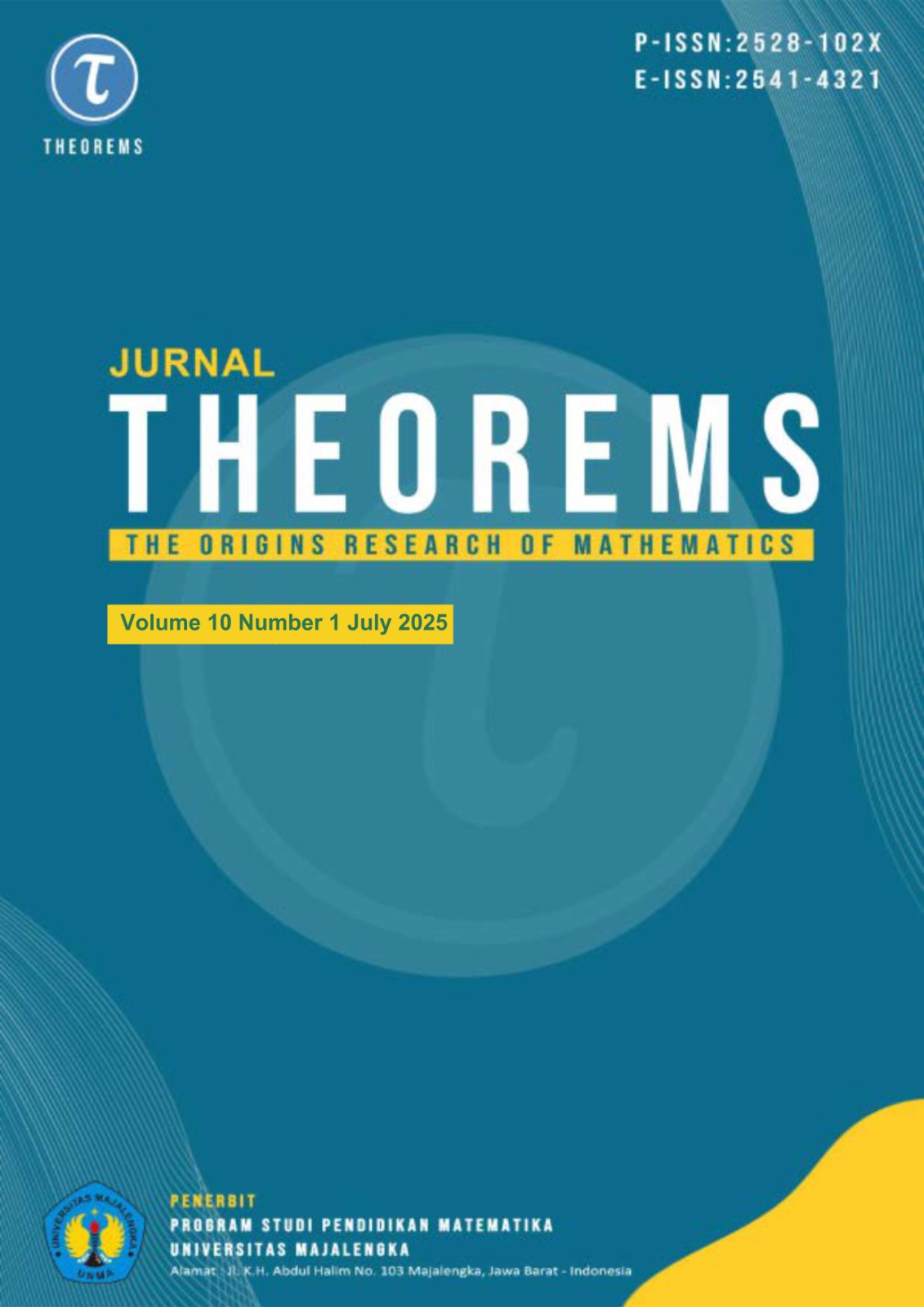Estimation of the effective reproduction number for the COVID-19 pandemic in Jakarta: A mathematical modelling approach
DOI:
https://doi.org/10.31949/th.v10i1.13746Abstract
A reproduction number that is less than 1 for 14 consecutive days is widely recognized as an essential indicator to assess whether epidemic conditions can be brought under control. This paper reveals how this indicator can be applied to evaluate the dynamics of an epidemic both at the early stage and toward its end within a specific region. The effective reproduction number (Rt), obtained based on the SIR (Susceptible, Infectious, and Removed) model and formulated through a finite difference equation, serves as a practical tool to assess the controllability level of an epidemic. Furthermore, by utilizing contact tracing data provided by the Government for COVID-19 suspects, the value of this indicator can be estimated accurately using the developed mathematical formulation. In this study, data were sourced from the official COVID-19 File History of DKI Jakarta, covering the period from July 24 to August 7, 2020. The calculated Rt values were then compared with those reported in similar studies to validate the findings. Differences in outcomes can be attributed to several factors, including variations in methodology, differences in time frames used for sampling, distinct regional epidemic characteristics, government-implemented social restriction policies of varying intensity, as well as vaccination strategies and public compliance levels. These influencing factors underscore the importance of context-specific analysis in using Rt as a reliable indicator for epidemic control evaluation
Keywords:
effective reproduction number, basic reproduction number, Covid-19 pandemic, finite difference methodsDownloads
References
Alimohamadi, S., Taghdir, M., & Sepandi, M. (2020). Estimating the reproduction number of COVID-19 in early epidemics: A systematic review. Journal of Preventive Medicine and Public Health, 53(3), 151–163. https://doi.org/10.3961/jpmph.20.076
Armita, N. L. G. S., Harini, L. P. I., & Utari, I. A. P. A. (2024). Model matematika SIR pada penyebaran penyakit COVID-19 dengan efektivitas vaksin. E-Jurnal Matematika, 13(1), 38–44. https://doi.org/10.24843/MTK.2024.v13.i01.p439
Brauer, F., & Carlos-Chavez, C. (2001). Mathematical models in population biology and epidemiology. Springer-Verlag.
Buckee, C. O., & Balsam, S. (2020). Using mobile phone data to estimate the impact of travel restrictions on the spread of COVID-19 in Great Britain. medRxiv. https://doi.org/10.1101/2020.04.13.20062791
Chinazzi, M., Davis, J. T., Barrett, L., Marathe, M., Gao, S., Lu, H., ... & Vespignani, A. (2020). The effect of travel restrictions and social distancing on the spread of COVID-19 in China. Science, 368(6493), 493–497. https://doi.org/10.1126/science.aba9757
Cori, A., Gasser, T., Hinsley, W., Jombart, T., Cauchemez, S., & Ferguson, N. M. (2013). Estimating the time-varying reproduction number (R) of SARS-CoV-2 using national and subnational case counts. American Journal of Epidemiology, 178(9), 1505–1513. https://doi.org/10.1093/aje/kwt133
Din, A., Zaman, G., & Zeb, A. (2021). Analysis of a discrete-time epidemic model for COVID-19 with intervention strategies. Applied Mathematics and Computation, 390, 125623. https://doi.org/10.1016/j.amc.2020.125623
Du, Z., Wang, L., Cauchemez, S., Xu, X., Wang, J., Cowling, B. J., & Zhou, J. (2022). Reproduction number of the Omicron variant triples that of the Delta variant. Viruses, 14(4), 821. https://doi.org/10.3390/v14040821
Elbousty, M. R., & Rida, S. E. (2020). A discrete-time model for COVID-19 transmission dynamics with application to repression strategies. Chaos, Solitons & Fractals, 138, 109928. https://doi.org/10.1016/j.chaos.2020.109928
Fajar, M. (2020, March). Estimasi angka reproduksi Novel Coronavirus (Covid-19) kasus Indonesia [Preprint]. ResearchGate. https://doi.org/10.13140/RG.2.2.32287.92328
Fitriyah, A. (2022). Rumus bilangan reproduksi dasar COVID-19 dengan adanya vaksinasi dosis 1 dan 2. Limits: Journal of Mathematics and Its Applications, 19(1), 87–94. https://doi.org/10.12962/limits.v19i1.12249
Fraser, C., Donnelly, C. A., Cauchemez, S., Hanage, W. P., Van Kerkhove, M. D., Anderson, R. M., & Cummings, D. A. T. (2009). Real-time estimation of the epidemic potential of emerging infectious diseases. Science, 324(5930), 1337–1340. https://doi.org/10.1126/science.1173739
Ganasegeran, K., Ch’ng, A. S. H., & Looi, I. (2021). What is the estimated COVID-19 reproduction number and the proportion of the population that needs to be immunized to achieve herd immunity in Malaysia? A mathematical epidemiology synthesis. COVID, 1(1), 13–19. https://doi.org/10.3390/covid1010003
He, X., Hong, W., Pan, X., Lu, G., & Wei, X. (2021). SARS-CoV-2 Omicron variant: Characteristics and prevention. MedComm, 2(4), 838–845. https://doi.org/10.1002/mco2.110
Khan, M. A., Atangana, A., Gómez-Aguilar, J. F., & Alzahrani, E. O. (2020). Mathematical modeling of COVID-19 transmission dynamics and control strategies. Results in Physics, 17, 103108. https://doi.org/10.1016/j.rinp.2020.103108
Kucharski, A. J., Russell, T. W., Flasche, S., Eggo, R. M., Funk, S., Jarvis, C. I., ... & Edmunds, W. J. (2020). Impact of non-pharmaceutical interventions on the time-varying reproduction number of COVID-19 in Europe. BMC Medicine, 18(1), 1–11. https://doi.org/10.1186/s12916-020-01591-4
Lakshmi, S., & Narayanan, G. (2021). A discrete-time SEIR model with asymptomatic cases for COVID-19 epidemic. International Journal of Applied and Computational Mathematics, 7(3), 1–17. https://doi.org/10.1007/s40819-021-01127-z
Li, Q., Guan, X., Wu, P., Wang, X., Zhou, L., Tong, Y., ... & Feng, Z. (2020). Transmission dynamics of COVID-19 in the early stages of the outbreak in Wuhan, China. New England Journal of Medicine, 382(13), 1199–1207. https://doi.org/10.1056/NEJMoa2001316
Liu, L., Iketani, S., Guo, Y., Chan, J. F. W., Wang, M., Liu, L., ... & Ho, D. D. (2022). Striking antibody evasion manifested by the Omicron variant of SARS-CoV-2. Nature, 602(7898), 676–681. https://doi.org/10.1038/s41586-021-04388-0
Susanto, H., Nuraini, N. M., Soeharyo, W. B., Wicaksono, R., Kurniawan, R., & Martono, T. (2020). How many can you infect? Simple (and naive) methods of estimating the reproduction number. Communications in Biomath Sciences, 3(1), 28–36.
Tang, B., Wang, X., Li, Q., Bragazzi, N. L., Tang, S., Xiao, Y., & Wu, J. (2020). Estimating the basic reproduction number of COVID-19 and assessing the effectiveness of mitigation measures in Wuhan, China. Journal of Clinical Medicine, 9(5), 1410. https://doi.org/10.3390/jcm9051410
Weiss, H. (2013). The SIR model and the foundations of public health. MATerials MATemàtics, 3(17). http://mat.uab.cat/matematiques/
World Health Organization. (2020, May). Contact tracing in the context of COVID-19 (WHO guidelines). https://www.who.int/publications/i/item/contact-tracing-in-the-context-of-covid-19
Yulida, Y., & Karim, M. A. (2020, May). Pemodelan matematika penyebaran COVID-19 di Provinsi Kalimantan Selatan. E-Jurnal Binawakya, 14(10).
Published
How to Cite
Issue
Section
License
Copyright (c) 2025 Retno Maharesi

This work is licensed under a Creative Commons Attribution-ShareAlike 4.0 International License.








